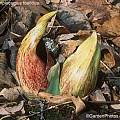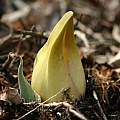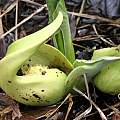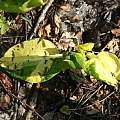Symplocarpus Salisb. ex W.P.C.Barton is a genus in the Araceae family with species native to North America and Asia. Growing from rhizomes, these plants are referred to as skunk cabbage since they smell unpleasant if they are crushed. Another genus with plants known as skunk cabbages is Lysichiton. Plants that Kew lists as accepted are listed below. Only Symplocarpus foetidus, Symplocarpus nipponicus and Symplocarpus renifolius seem to be grown.
Symplocarpus in my experience is best grown from fresh seed (Jim McKenney). Seed ripens in mid-autumn (around November) and begin to germinate right away. Seeds should be collected and potted up right away. Allowing the seeds to dry will cause the embryo to shrivel. See S. foetidus entry below for specific info on germinating seeds of that species.
Symplocarpus egorovii N.S.Pavlova & V.A.Nechaev is native to Russia.
Symplocarpus foetidus (L.) Salisb. ex W.P.C.Barton is native to northeastern North America. This species is one of the first to bloom in the spring, sometimes barely showing through the leaves or snow. It grows in damp places, often alongside (but not in) streams, mainly in the open, though sometimes under trees. The flowers are pollinated by flies and produce heat which would be a benefit to the flies early in the season when it is cold. The color of the spathe, the outer hood, varies from plant to plant. It can be red, purple, yellowish, greenish, or reddish-brown with spots. Skunk cabbage is also an important food for black bears when they first emerge from hibernation. The leaves emerge after the flowers. While oohing over the range of flower (spathe) color, the lovely size and boldness of the foliage are both more obvious than the flowers and much longer lasting. This aroid does have very large round cabbage-like foliage that can stay in very good shape for a long growth period. The flowers are fairly small and fleeting in comparison. Seeing a patch in full growth is very impressive; like a nice architectural Hosta, it has 'presence'. Height range: 1-3 ft.
Fresh, uncleaned (leave the gelatinous coating) seed germinates in early spring sown in a mix of half coarse sand and half milled sphagnum moss (not peat). Press seeds firmly into the surface, water once from the bottom (fungicide in the water optional) and leave outside exposed to the cold fall weather. The gelatinous coating will disintegrate naturally and the seeds will germinate in the spring. It is not necessary to store the seed (Mark Mazer). However, Jim McKenney reports that seed in his Maryland populations germinates in the fall and goes into winter with 2-3 inch (5-8 cm) of root in the soil.
The first two photos are by Graham Rice. He states: The spathe in the first picture, reddish-purple and green streaks, is fairly typical in our area of Pennsylvania. The second picture, below, shows a clump with striking dark purple spathes growing on a damp part of the rock garden at the Royal Botanic Gardens at Kew, when I was a student there in 1975. The third through fifth photos, by Sean Zera, show a range of color extremes in wild populations in southern Michigan: a nearly solid yellow spathe with just a tint of red, a green spathe with no yellow or red pigment whatsoever, and a plant with dramatically variegated leaves.
Symplocarpus koreanuskoreanus? Joon S.Lee, Seon H.Kim & S.C.Kim is native to Korea's marshy wetlands. It has distinctive broad leaves and a central spadix encased in a protective spathe that ranges in color from green to purplish.
Symplocarpus nabekuraensis Otsuka & K.Inoue is native to Japan where it grows in wetland and marshy areas of mountainous regions. It is a rare species that features a distinct aromatic inflorescence and robust, lobed foliage.
Symplocarpus nipponicus Makino is native to Japan, northeast China, and Korea. It is found in forested and wetland areas.
Symplocarpus renifolius Schott ex Tzvelev is from Asia (Korea, Manchuria, Russia, Japan). It has reniform (kidney-shaped) leaves and the spathe and outer hood are purple. The spadix is also purple, but the densely arranged flowers are yellow. The leaves emerge after the flowers start to die back.




